Any conifer belonging to the Pinus genus of plants is known as a pine tree; there are more than 120 different varieties of pine trees worldwide. These woody plants are called evergreen conifers, and instead of the broad leaves typically seen on deciduous trees, they contain bundles of needles instead of seed cones.
You will read about the different kinds of pine trees in this post. You may identify pines by using their scientific names, descriptions, and images.
1. Arizona Pine

Botanical Name: Pinus arizonica
Height: 80-112 feet
Hardiness-Zones: 6-8
Arizona pines, or Pinus arizonica, are native to the southwest region of the United States. South-East Arizona, South-West New Mexico, and parts of higher Mexico have the ideal weather for growing Arizona pine.
This species, which is native to Arizona, has rounded tips, thick, widely dispersed branches, and three to four bunches of needles. An established Arizona pine tree can reach a height of 112 feet and has a broad trunk, making it a comparatively larger pine tree.
The majority of Arizona pines are located at heights between 7,000 and 7,500 feet, on slopes, in canyons, and in other elevated areas, making them inaccessible. The Arizona pine’s entire expansion area has decreased as a result of heavy harvesting by people in Mexico.
2. Japanese white pine

Botanical Name: Pinus parviflora
Height: 25-50-foot-tall
Hardiness Zones: 7-10
Japanese white pines are elegant, well-formed trees with soft, delicate needles that frequently have gold, blue, or white streaks running through them.
Their resilience may not match that of mugos, but they thrive in garden settings with proper drainage and some afternoon shade in hot climates. The above-mentioned ‘Fukuzumi’ boasts beautiful blue-green needles and a naturally windswept habit. Nobody has ever pruned this specimen.
3. Red Pine
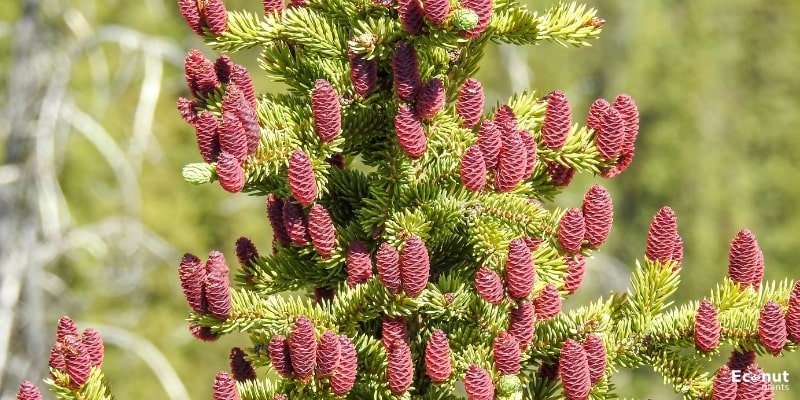
Botanical Name: Pinus resinosa
Height: 75 feet
Hardiness Zones: 2
Red pine can reach heights of up to 75 feet, contingent upon the surrounding circumstances. Its scaly plates are found on its typically reddish-brown, occasionally pink or grey bark. Red pines are around 4-6 inches long, with two needles each fascicle.
4. Maritime Pine
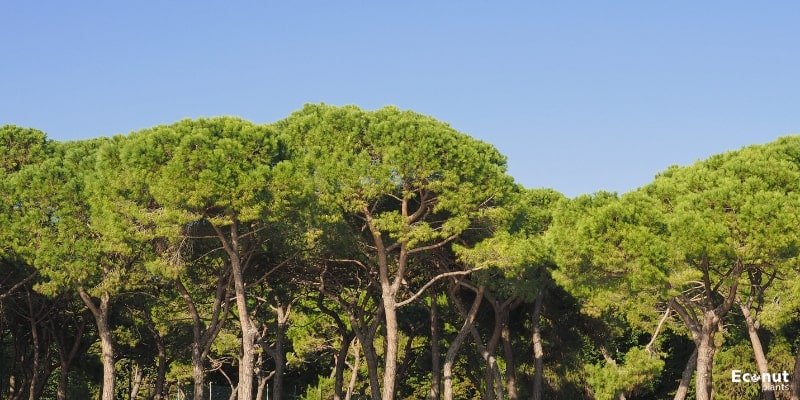
Botanical Name: Pinus pinaster
Height: 80-100 feet
Hardiness Zones: 7-8
Pinus pinaster, sometimes called maritime or Mediterranean pine, is most likely the most abundant pine species in the Perth metropolitan region. North of Perth, maritime pine makes up the majority of the plantations.
5. Scots Pine
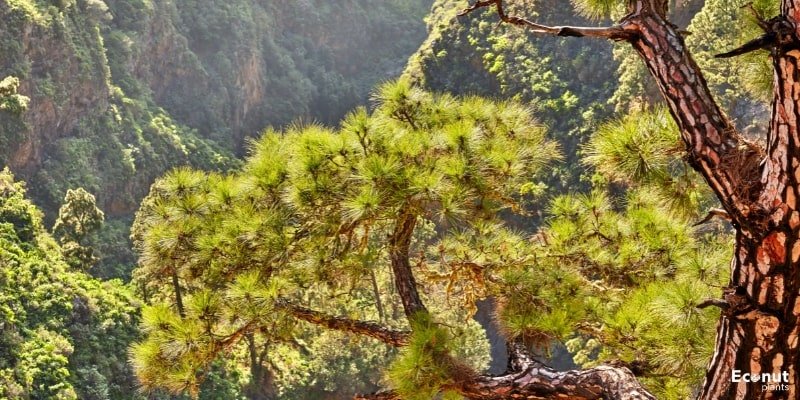
Botanical Name: Pinus sylvestris
Height: 30-60 feet
Hardiness Zones: 3-7
We travel to Europe and Asia, where the orange-brown bark and thin needles of the Scots pine greet us. With its ability to adapt, this species highlights the diversity of pine trees found on different continents and their significance in forming the distinctive biodiversity of diverse settings.
6. Chir Pine
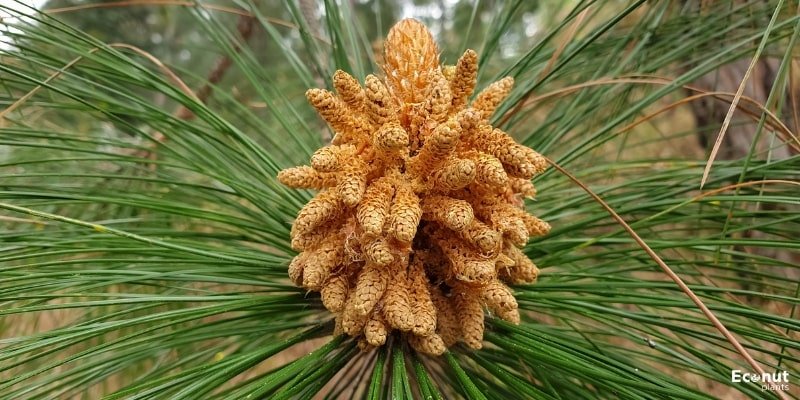
Botanical Name: Pinus roxburghii
Height: 100-180 feet
Hardiness Zones: 8-11
Chir pine, also called Indian Longleaf pine, is native to the Himalayas and is commonly found in most southern U.S. forests. It is frequently exploited in those regions for lumber production. In dry seasons, Pinus roxburghii’s long, deciduous needles shed, but they often stay on the tree for the majority of the year.
7. Pitch Pine Trees

Botanical Name: Pinus rigida
Height: 80-100 feet
Hardiness Zones: 4-7
Pit Pine Even a person with minimal tree expertise can easily identify a tree. This is because their needles grow in characteristic three-clump formations. These extremely sharp-tipped needles can grow in a straight line or be twisted. These trees can also be recognized by the yellow-green tint of their needles.
Pitch pine trees grow about one foot every year of their lives, which makes them rather tall, even though they are not as tall as some of their cousins.
8. Longleaf Pine
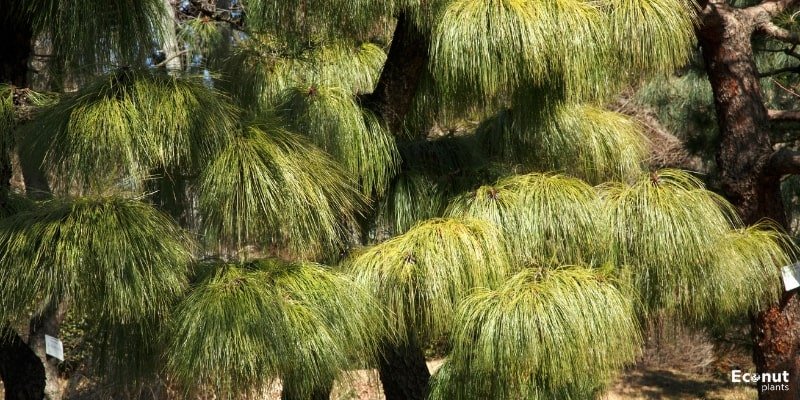
Botanical Name: Pinus palustris
Height: 100-120 feet
Hardiness Zones: 7-10
One extremely tall type of pine tree is the longleaf pine, which typically has a short, relatively thin canopy and a long, naked trunk. If planted appropriately, they can still offer some shade at a To offer enough shade, most landowners plant many longleaf pines.
This species’ main attraction is how little cleanup is needed because its canopy is smaller than that of most other species. This species might be what you’re searching for if you want shade without having to sweep up needles and cones all the time.
9. Monterey Pine
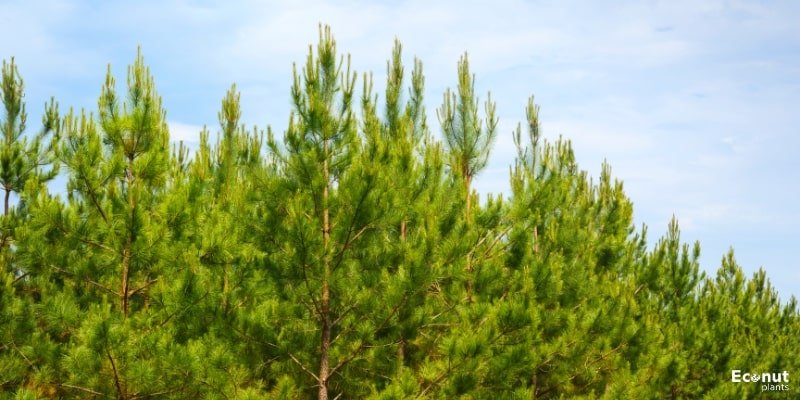
Botanical Name: Pinus radiata
Height: 50-115 feet
Hardiness Zones: 7-10
Its unique look makes it one of the pinus genus’s easiest to identify. Despite its size, the trunk is curved rather than straight. The black bark appears to be ribbed and cracked.
Its green needles are grouped in fascicles of two or three and have an umbrella-shaped crown. The cones have three colours and are pointy and broad. It is green when it is young. It eventually turns brown, and then almost completely black.
This species is indigenous to Mexico and California. Because of its unusual shape and the difference in colour between the leaves, it has a striking presence in the environment.
10. Aleppo Pine
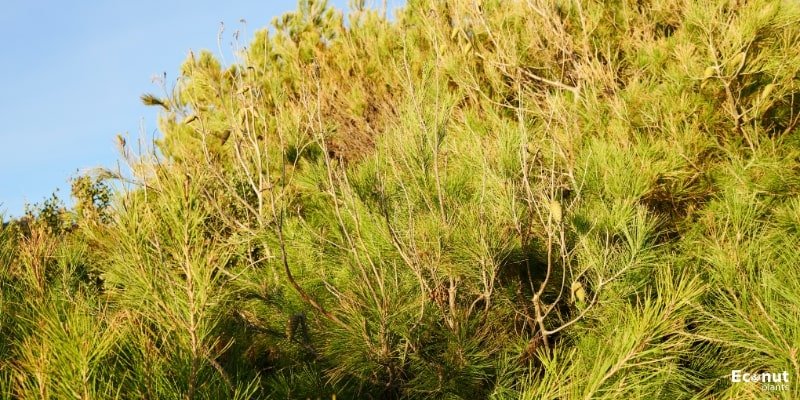
Botanical Name: Pinus halepensis
Height: 50-80 feet
Hardiness Zones: 8-11
On our list of various pine tree species, the Aleppo pine comes in first. The Mediterranean region, spanning from Morocco and Portugal in the west to the Sinai Peninsula in the east, is home to this particular variety of pine. With a tolerance for temperatures as low as -15 °C, the Aleppo pine is an extremely resistant plant.
Its longitudinally fissured bark ranges in colour from dark grey to brown. It yields cones that are 5-7 cm long and have edible seeds inside that ripen in the late summer.
Because it requires little upkeep, can grow in a variety of soil types, and is resistant to pests and diseases, Aleppo pine is frequently used in landscaping. It’s a popular choice for parks, gardens, and other green spaces because it can be cultivated in cities.
11. Shortleaf Pines
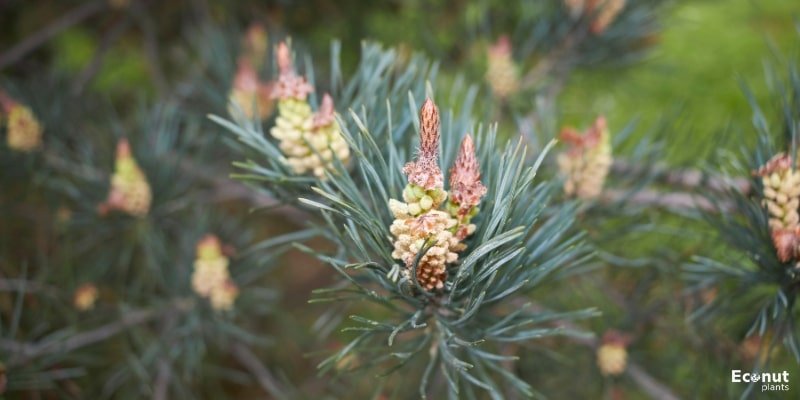
Botanical Name: Pinus echinata
Height: 80 to 100 feet tall
Hardiness Zones: 6-8
Eastern Texas pines, or shortleaf pines, are found on slopes, hills, and upland woodlands. Although they can withstand freezing temperatures, shortleaf pines cannot be planted beside loblolly pines.
The tree has short, dark yellow-green needles that are three to five inches long and reddish-brown cones that are formed like eggs.
12. Eastern White Pine
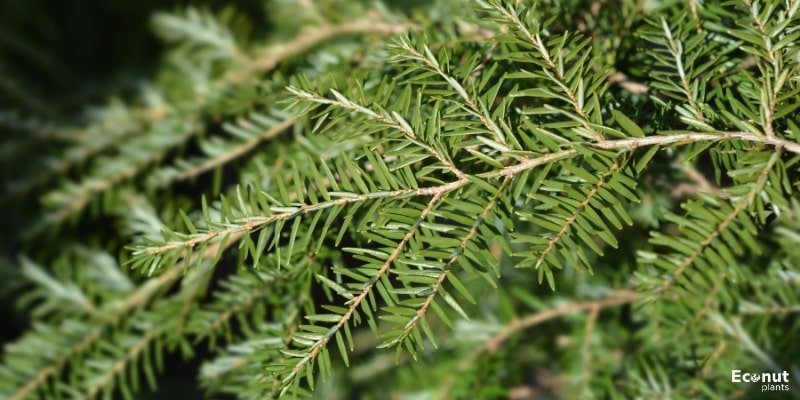
Botanical Name: Pinus strobus
Height: 50-100 feet
Hardiness Zones: 4-9
One of the most significant pine species in North America, it grows quickly and has a long lifespan. Although the eastern white pine, often known as just a white pine, is a huge tree by nature, it can be trained to grow as a hedge shrub by simply pruning it.
With age, the smooth grey bark develops fissures. When this tree is young, it may suffer if planted as a street tree since it does not withstand pollution as well as certain other species of pine trees.
13. Bishop Pine
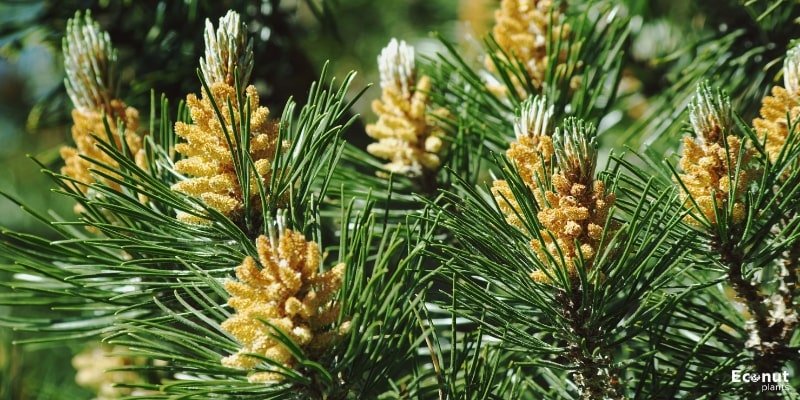
Botanical Name: Pinus muricata
Height: 40-50 feet
Hardiness Zones: 7-9
The southernmost coastal counties of Oregon and the California coast are home to Pinus muricata trees. Known by most as the Bishop pine, this tree is a dominant species in forests of closed-cone pines.
The Bishop pine features upward-extending branches, upward-curving needles in pairs, and dark grey bark. This species can reach heights of 40 to 50 feet, and it occasionally has many trunks extending from its base. Bishop pines are good for creating paper and are a good choice for stabilizing dunes and preventing erosion.
14. Uncle Fogy
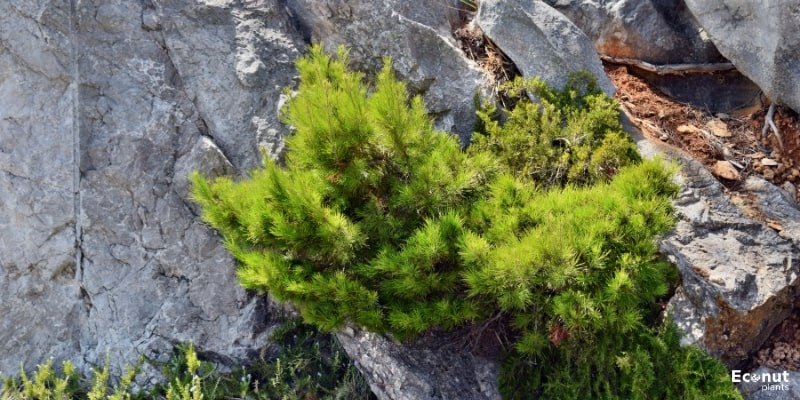
Botanical Name: Pinus banksiana
Height: 2–3 feet tall
Hardiness Zones: 2-7
‘Uncle Fogy’ has got to be one of the most absurd pines, even if Pinus parviflora varieties are among the most exquisite.
Compared to many other pine species, Pinus banksiana, or jack pines, grow more erratically in the wild. Among all of them, “Uncle Fogy” is remarkably erratic, growing occasionally straight for a while before collapsing to the ground and frequently rising again.
Being one of the greatest cultivars for shape and pruning, you may add a personal touch to your ‘Uncle Fogy’! Once established, jack pines are hardy plants that need little maintenance and little water.
15. Jack Pine
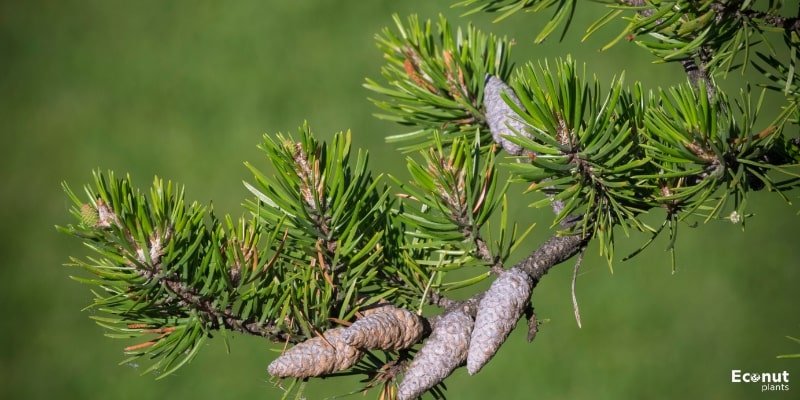
Botanical Name: Pinus banksiana
Height: 30-100 feet
Hardiness Zones: 3-8
The Great Lakes region and some areas of Canada are home to the small- to medium-sized jack pine species. With short bundles of needles, this evergreen tree grows quickly. Its crown is thin and rounded. Jack pine is frequently used to make lumber and, occasionally, for landscaping.
16. ‘Oregon Green’ Pine
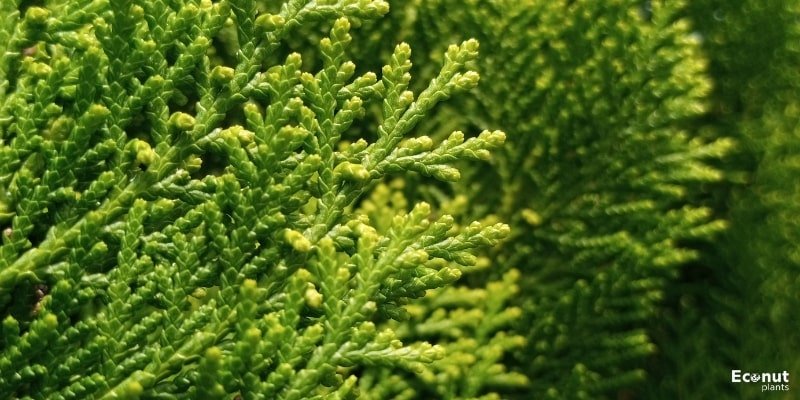
Botanical Name: Pinus nigra
Height: 18 to 20 ft
Hardiness Zones: 4-2
Prized for its striking foliage and upward-spreading growth habit, ‘Oregon Green pine is a favourite of professional landscapers who use it to create eye-catching interest in the landscape.
New branch growth appears in spring as bright white vertical “candles” on the tips of the branches, providing a stark contrast against the rest of the tree’s rich green leaf needles. As summer progresses, the white of the new growth turns deep, glossy green.
17. Ponderosa Pine
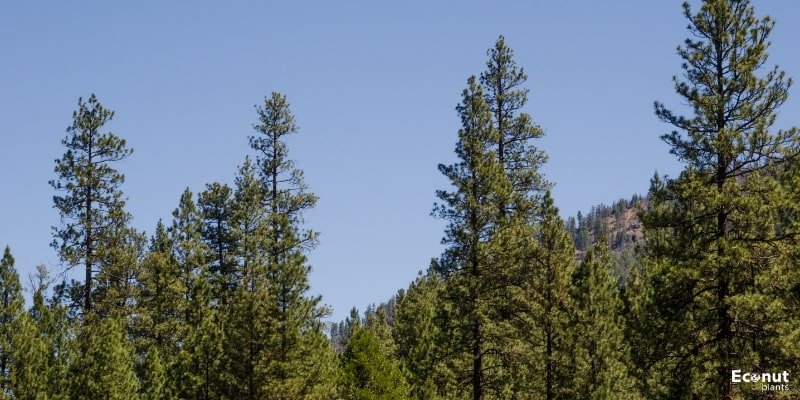
Botanical Name: Pinus ponderosa
Height: 30-50 m
Hardiness Zones: 3-7
The western regions of North America are home to the majestic Ponderosa Pine, which is distinguished by its towering height and unique cinnamon-coloured bark. This species is important economically as well as aesthetically, highlighting the delicate balance between ecological harmony and human use.
18. Loblolly Pine
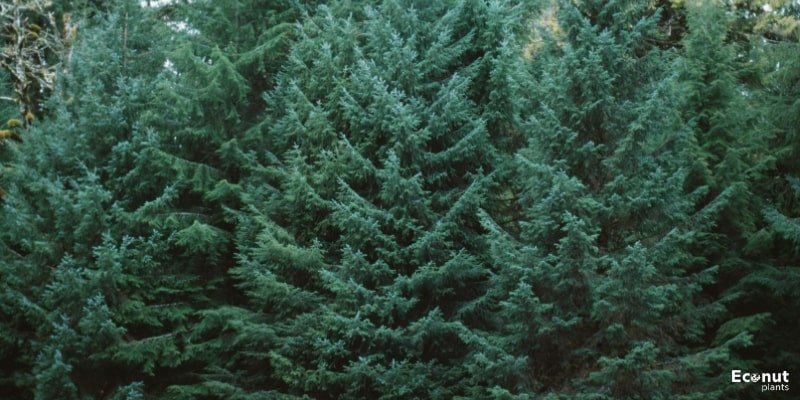
Botanical Name: Pinus taeda
Height: 60-90 feet
Hardiness Zones: 6-9
Natural pine trees, or loblolly pines, are found throughout the American South, from Texas to Florida to Maryland and the Atlantic Ocean. Because they were not designed for mountainous climates, they are more common in Virginia’s eastern portion.
Mature loblolly pines will soften out into a reddish colour, while young trees will have very dark, almost black bark. Until they reach a considerable height above the ground, these trunks will be tall, straight, and branchless.
19. Southern White Pines

Botanical Name: Pinus strobus
Height: 180 feet tall
Hardiness Zones: 3–7
The rarest Texas pine trees are the southern white pines. Their bark is silver-white, which sets them apart from other types of pine. It features lovely clusters at the tips of twigs, with tiered branches and blue-green needles.
20. Luchu Pine
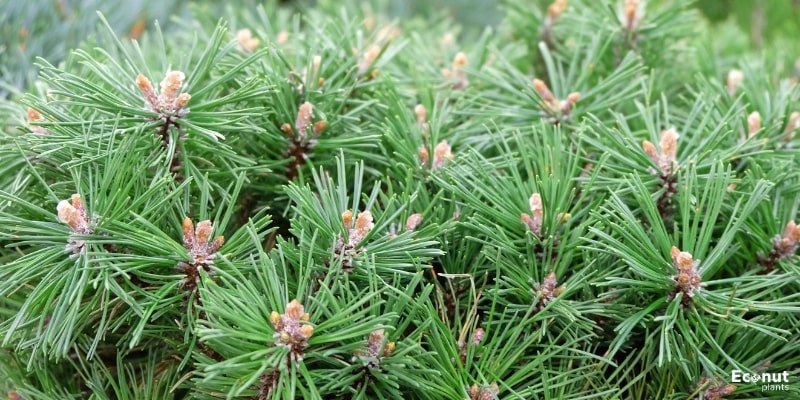
Botanical Name: Pinus luchuensis
Height: 50-80 feet
Hardiness Zones: 8-10
The bark of Pinus luchuensis is smooth and gray, and its dark-green needles have a flat top and slope upward. This species has the potential to reach heights of 50–80 feet.
North Eurasia is home to this pine tree’s original nations, notably the Japanese islands of Okinawa and Ryukyu. Ryukyu Island pines grow at lower elevations close to sea level.
21. Mugo Pine
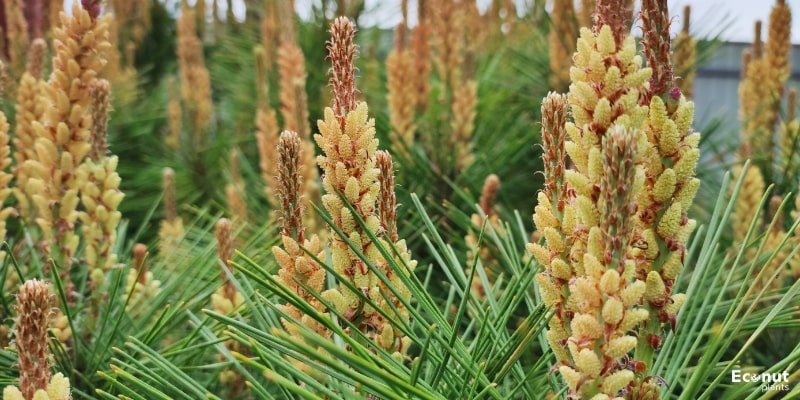
Botanical Name: Pinus mugo
Height: 20-25 feet
Hardiness Zones: 2–7
Dwarf pine varieties, like mugo pine, are widely used in gardening. Numerous varieties exist, some of which have colourful foliage. It’s a really large species; some are small trees, and some are shrubs.
They split to create spherical forms that match in height and spread. There are two fascicles on each needle. There are little fissures in the brown-grey bark. The cones are ovoid, tiny, and have few scales.
Despite its diminutive size or perhaps precisely because of it mugo pine is a gardening giant! There are many different kinds available on the market that you can use as ground cover, hedges, borders, or even as a shrub.
22. Canary Island Pine
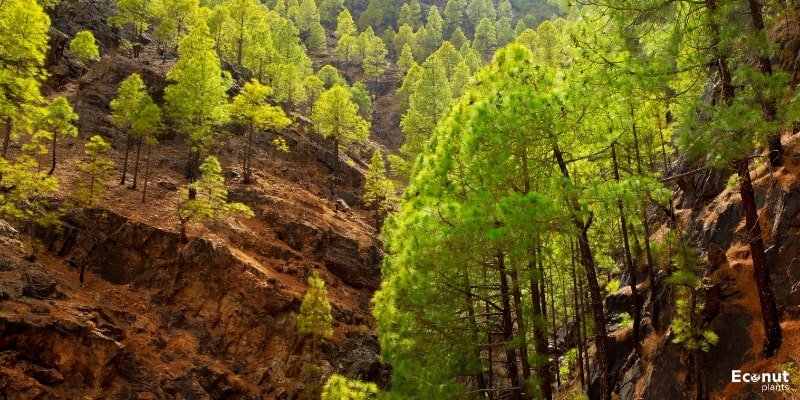
Botanical Name: Pinus canariensis
Height: 80 to 100 feet
Hardiness Zones: 8-9
Large evergreen trees indigenous to the Canary Islands are called Canary Island Pines. Its leaves resemble needles and have a pale green colour. It has scaly, grey bark with tiny horizontal ridges.
This tree is well-known for its hardiness, drought resilience, and capacity to withstand low temperatures. Because of its extreme durability, Canary Island pine wood is a popular option for flooring, furniture, and even tools, Because of its strength, it is also used to make the hulls of ships and boats.
23. Slash Pine
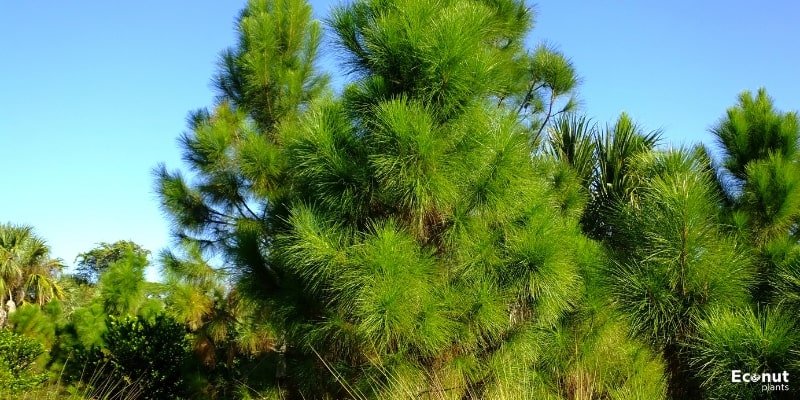
Botanical Name: Pinus elliottii Engelm
Height: 100 feet
Hardiness Zones: 8-10
The conifer tree Pinus elliottii, also referred to as slash pine, is indigenous to the Southeast region of the United States.
The “slashes” that make up the habitat of slash pine are areas of marshy terrain covered in plants and trees. Southern Florida pine, yellow slash pine, and swamp pine are some other common names for this species.
24. Jeffrey Pine
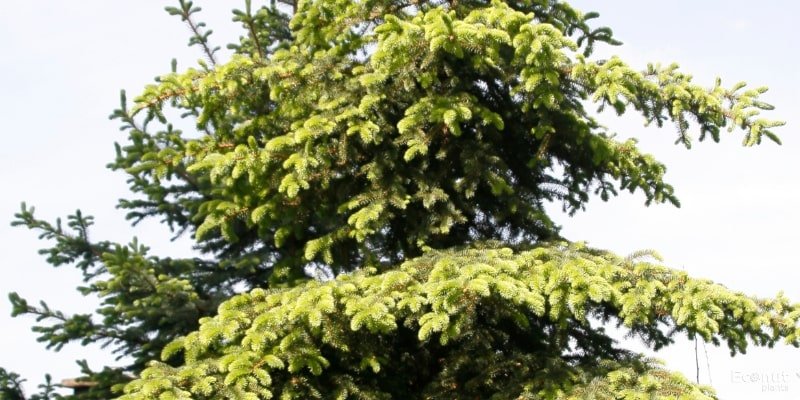
Botanical Name: Pinus jeffreyi
Height: 80-100 feet
Hardiness Zones: 6-8
Seldom is effrey pine planted in landscape settings, despite being a fairly tall and sparse tree. It can withstand droughts and bad soils rather well. There’s a vanilla scent to the black bark, and the young branches have a pretty grey bloom.
25. Bosnian Pine
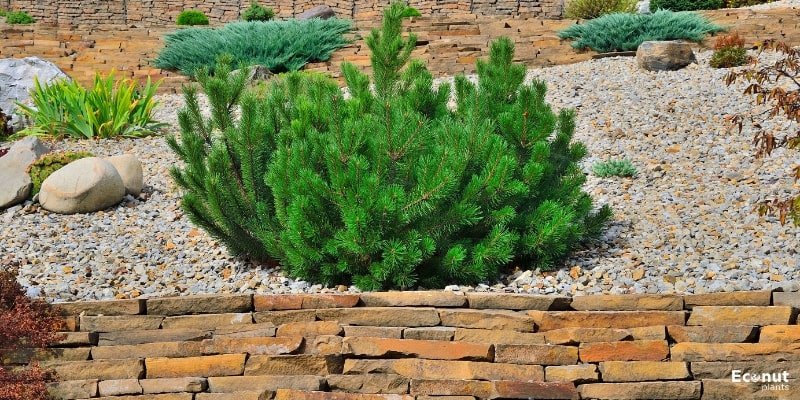
Botanical Name: Pinus heldreichii
Height: 30-40 feet
Hardiness Zones: 6-8
This tree, sometimes known as the Bosnian pine, is indigenous to Serbia, Albania, Bosnia, Bulgaria, and Greece. Theodor von Heldreich, a Greek botanist who made the discovery of this species of Pinus in the later part of the 19th century, is credited with giving it its name.
Pinus heldreichii is a slow-growing pine with bark that is dark gray and stiff, dark green needles. This species’ branches curve upward and outward from the stem, forming an oval or pyramid shape as it matures. The Bosnian pine is susceptible to rust and root rot when planted outside of its natural habitat.
26. Lodgepole Pine
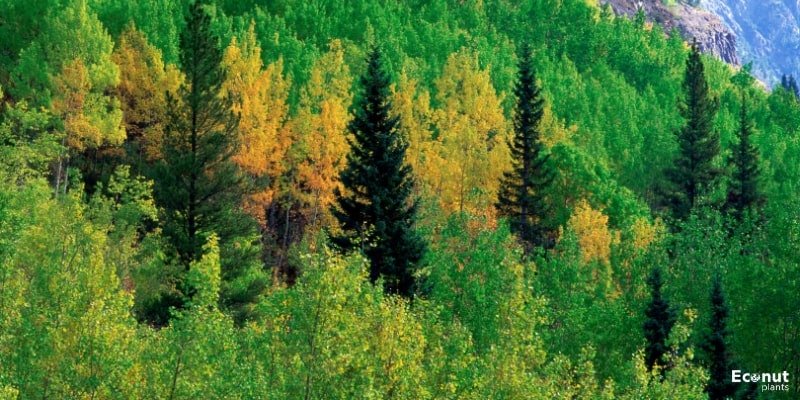
Botanical Name: Pinus contorta
Height: 700 feet
Hardiness Zones: 3-7
The small crown and slender trunk of lodgepole pine are distinguishing characteristics. It can survive in both high- and low-moisture environments. Although they grow quickly and can reach heights of up to 150 feet, many lodgepole pines are typically smaller.
27. Lacebark Pine
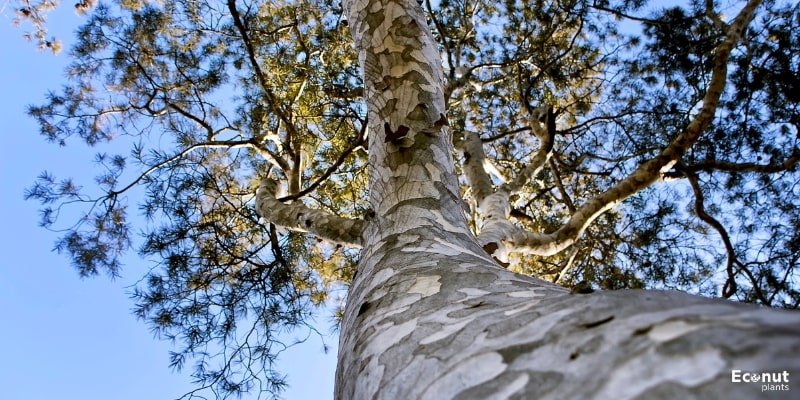
Botanical Name: Pinus bungeana
Height: 30-50 feet
Hardiness Zones: 5-9
The bark of the lacebark pine exfoliates easily, making it easier to identify. It comes off ten consecutive trunks in a gorgeous patchwork of russet, cream, silver gray, and white! Should this be insufficient for identification, the habit is oval but upright, and the trunk branches out at a lower level.
This conifer has really amazing bark! Because of this, it makes a great garden plant. You may grow it in small groups or as a specimen plant. Its marble-like bark would also look great in formal and urban gardens.
28. Pencil Point Juniper
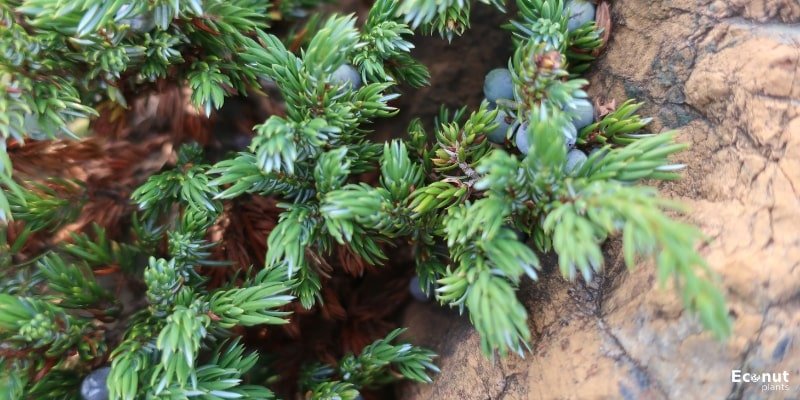
Botanical Name: Juniperus communis ‘Compressa’
Height: 5 feet
Hardiness Zones: 2-6
You can shape the thick canopy of the Pencil Point Juniper to give your property a touch of beauty. When completely grown, it only reaches a height of five feet, which makes it perfect for bordering your property or adding some sophistication to a garden area.
This tree needs little maintenance, can grow in most American climates, and maintains a beautiful appearance even without shaping or pruning. If you’re looking for a low-maintenance Plant with a large impact on your landscaping, this might be the perfect pine.
29. Nut Pines and Pinyons

Botanical Name: Pinus monophylla
Height:10–20
Hardiness Zones: 6-8
West Texas is home to pinyon trees and nut pines. Both of these trees have a triangular shape and can reach heights of 70–80 feet; however, they typically only reach 20–30 feet. Pinyons have a circular crown, whereas the nut pine has a conical one. Nut pines have hard shells that contain tasty nuts.
30. Limber Pine
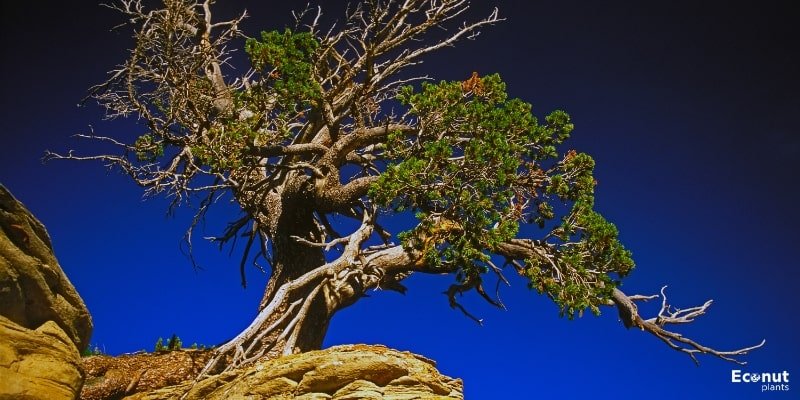
Botanical Name: Pinus flexilis
Height: 30-60 feet
Hardiness Zones: 4-7
A very versatile tree that thrives in challenging soils is the limper pine. It is suited for difficult situations, including poor soil, when planted in landscapes.

